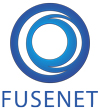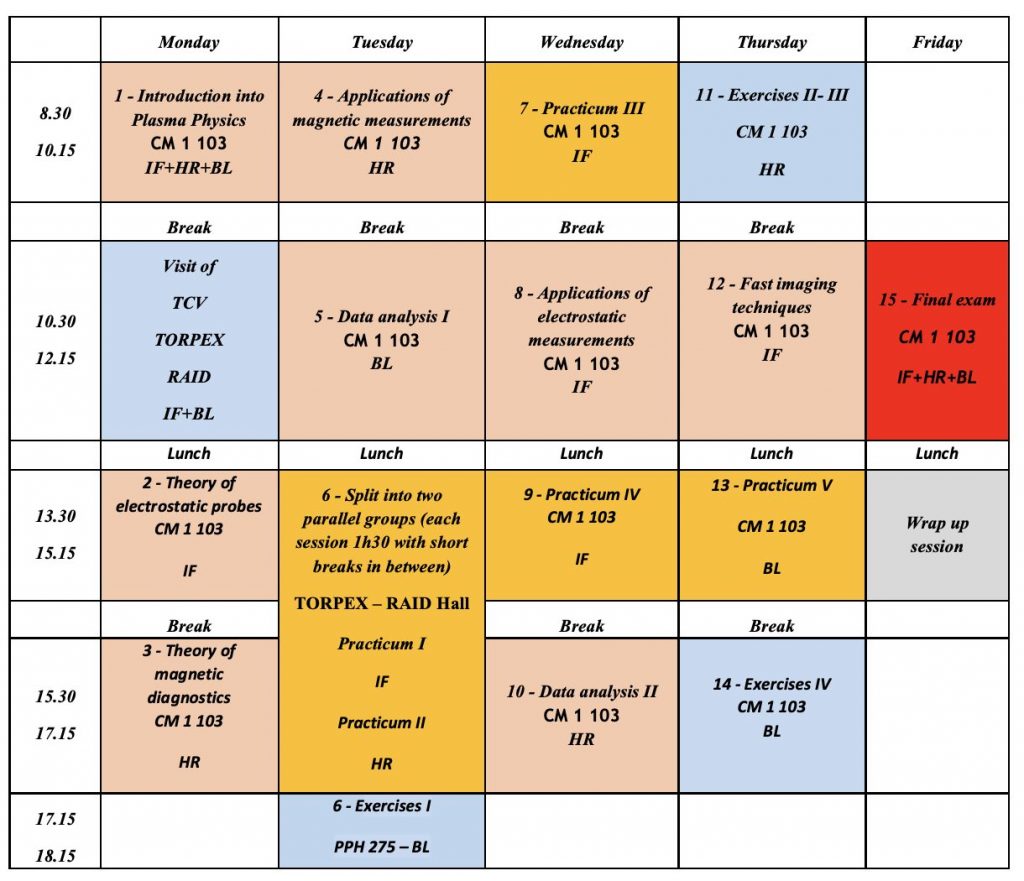
A course supported by the European Fusion Education Network
Date: January 29th – February 2nd, 2024
ECTS credits: 2
Lecture 16 Hour(s) Recitation 10 Hour(s) Practical work 10 Hour(s)
Location: CM1 103 – Ecole Polytechnique Fédérale de Lausanne (map)
Prerequisite: a basic knowledge of Matlab software; a basic knowledge of plasma physics.
Subscription: Please send the following form to [email protected]: form (word) (pdf)
Objectives: This course provides the theoretical background on electrostatic probes, magnetic probes and fast imaging in plasmas. Each lesson will be followed by class exercise and experimental practica on both the TCV tokamak and the TORPEX basic plasma physics device.
Content: Theory of magnetic probes: Rogowski-coil, Flux loop, Diamagnetic loop, Poloidal field probes, Non-axisymmetric measurements, Poloidal field probes, Saddle loops. Data analysis techniques: mode identification using MHD spectroscopy (spectrogram – autocorrelation), Cross-correlation, Toroidal mode decompostion/general least square fit/ Sparse spec, Singular Value Decomposition. Practicum: calibration of magnetic probes and measurements of transfer function, analysis of TCV data. Theory of various types of electrostatic probes, including single, double, and triple probes, Katsumata, ball pen, emissive probes, Mach probes, energy analyzers, turbulent particle flux probes. Data analysis techniques: Fourier analysis, Higher order Fourier analysis, Statistical analysis, Conditional sampling.
Practica: measurements of time averaged quantities and fluctuations in TORPEX and TCV data using single, double and triple probes; measurements of fluctuations in TORPEX, including statistical properties (skewness, etc.) perpendicular wave number and particle flux. Theory of plasma emission and fast imaging. CMOs/CCD cameras, fast framing cameras, streaked cameras; Image intensifiers; Gas-puffing systems. Data analysis techniques: Fourier based techniques (linear and higher-order techniques); space-based techniques (structure identification, etc.). Practicum: installation and use of the fast camera to image radially propagating blobs in TORPEX; determination of physical quantities such as blob speed and size; use of advanced data analysis techniques, such as conditional sampling and box-averaging. On TCV: data analysis of camera data.
Past editions: 2012 (photo), 2014, 2016, 2018 (photo), 2022 (photo), 2024 (photo)
![]()

Content details
Program details
1 – Introduction into Plasma Physics (2 hours – Furno) — slides (back to table)
Introductory lecture
Visit of TCV and TORPEX (2 hours – Furno – Labit ) (back to table)
Students will be given a guided tour of the TCV and TORPEX experimental devices. Relevant diagnostics will be briefly illustrated with a particular focus on differences among the two installations (technology, constraints, etc…).
2 – Theory of electrostatic probes (2 hours – Furno) — slides (back to table)
In this lecture, we will review the theory of various types of electrostatic probes, including single, double, and triple probes, Katsumata, ball pen, emissive probes, Mach probes, energy analyzers, turbulent particle flux probes.
3 – Theory of magnetic diagnostics (2 hours – Reimerdes) — slides (back to table)
This lecture gives an overview of various magnetic measurements. It includes measurements of axisymmetric fields (flux loops and poloidal field probes), global plasma parameters (Rogowski-coil and diamagnetic loop) and deviations from axisymmetry (poloidal field probes and saddle loops).
4 – Applications of magnetic measurements (2 hours – Reimerdes) — slides (back to table)
The students will be introduced to the main applications of magnetic measurements, which includes the reconstruction of the current distribution in the plasma (ideal MHD equilibria) and the identification of instabilities.
5 – Data analysis techniques I (2 hours – Labit) — slides (back to table)
In this lecture, different data analysis techniques will be reviewed with a particular focus on Fourier analysis (linear and higher-order techniques), statistical methods, conditional sampling techniques, and space-based techniques (structure identification, etc.).
6 – Practicum I – The real world: experimental data taking campaign (2 hours – Furno) (back to table)
Students will learn specific aspects of electrostatic probes with hands-on training on the TORPEX device. The practicum will allow students to learn plasma diagnostics and data processing/storage methods of modern fusion experiments (i.e. MDS+) and to bridge the gap between diagnostics theory and experimental practice. The diagnostics will be setup by students and they will performed directly the following measurements on the TORPEX device:
- Using a single Langmuir probe, floating potential, ion saturation current, I-V curve;
- Using a triple Langmuir probe, time evolution of electron density, temperature and plasma potential;
- Using a gridded energy analyzer, electron distribution function.
- Using a fast framing camera to acquire visible light fluctuation measurements
6 – Practicum II: Calibration of a magnetic probe (2 hours – Reimerdes) — slides ( back to table)
The students will use a set of Helmholtz coils to measure the signal of a magnetic probe at various frequencies. The transfer function will be parametrized using MATLAB routines and the effective area extracted.
6 – Exercises I: How to design an electrostatic probe (1 hour – Labit) — exercises — solutions (back to table)
The students will learn the design principles of an electrostatic probe. Experimental constraints and requirements are discussed and possible solutions suggested.
7 – Practicum III – Learning to interpret electrostatic probe data (2 hours – Furno) — Instructions how to connect to LAC servers (back to table)
Students will access and analyze data from the TORPEX device and the TCV tokamak using Matlab routines. In particular, they will analyze experimental data obtained in Practicum II. The following subjects will be covered:
- How to interpret ion saturation current and floating potential from a single Langmuir probe and how to deal with non ideal effects, such as bandwidth limitation.
- Building experimental I-V characteristics from swept Langmuir probes in TORPEX and TCV plasmas. How to interpret the I-V characteristics and extract time-averaged electron density, electron temperature and floating/plasma potential? How to deal with non-ideal effects such as probe contamination (hysteresis) and sheath expansion?
- How to measure time evolution of electron density, electron temperature and floating/plasma potential using a triple Langmuir probe. How to deal with non ideal effects, such as the finite size of the probe tips.
- How to measure the electron distribution function using data from a gridded energy analyzer.
8 – Application of electrostatic measurements (2 hours – Furno) — slides ( back to table) ///
The students will learn various applications of electrostatic probes, such as, for example, how to measure a statistical dispersion relation to investigate electrostatic instabilities.
9 – Practicum IV – Advanced use of electrostatic probes (2 hours – Furno) (back to table)
Students will access and analyze data from the TORPEX device and the TCV tokamak using Matlab routines. In particular, they will analyze experimental data obtained in Practicum II. The following subjects will be covered:
- Using data from a single Langmuir probe and multiple Langmuir probes: identification of spectral (linear and higher order) and statistical properties (i.e. spectrum, correlation, dispersion relation, skewness, kurtosis, etc…). Discover plasma electrostatic instabilities and build the statistical dispersion relation.
- Using data from multiple Langmuir probes: application of conditional sampling and BOX-CAS analysis both on TORPEX and TCV data. Discover the blob propagation and ELMs in tokamaks.
10 – Data analysis techniques II (2 hours – Reimerdes) — slides (back to table)
Various methods to analyse magnetic fluctuation measurements are introduced. The methods include mode identification using MHD spectroscopy and spectrograms. Toroidally distributed measurements can be analyzed using toroidal mode decomposition. The analysis can be generalized using a general least square fit. Capabilities of the Singular Value Decomposition are also highlighted.
11 – Exercises II: Analysis of magnetic fluctuation measurements from TCV (2 hours – Reimerdes) (back to table)
The students will have access to TCV data. They will learn how to retrieve experimental signals and visualise them using MATLAB. They will analyse the signals using the methods introduced in Data analysis techniques I & II. Data access routines and basic analysis routines will be supplied.
11 – Exercises III: Interpretation of magnetic measurements (2 hours – Reimerdes) (back to table)
The students will calculate magnetic signals using filament models. The modeled signals are then compared to measurements during the current ramp up in TCV.
12 – Theory of plasma emission – fast imaging techniques (2 hours – Furno) — slides (back to table)
In this lecture, the basic mechanisms of light/radiation emission from plasmas will be reviewed. Next, fast imaging techniques in plasmas will be introduced with a focus on CMOs/CCD cameras, fast framing cameras, streaked cameras, image intensifiers, and gas-puffing systems.
13 – Practicum V – Data analysis from fast framing cameras (2 hours – Labit) — slides (back to table)
Students will access and analyze data from fast framing cameras both from the TORPEX device and the TCV tokamak using Matlab routines. They will use techniques such as fft, conditional sampling, etc… to get insights into the physics of turbulence (waves, filaments, blobs).
14 – Exercises IV: putting all together (2 hours – Labit ) — slides (back to table)
The students will use magnetic data, LP data and fast imaging data to extract physics information in a TCV discharge.